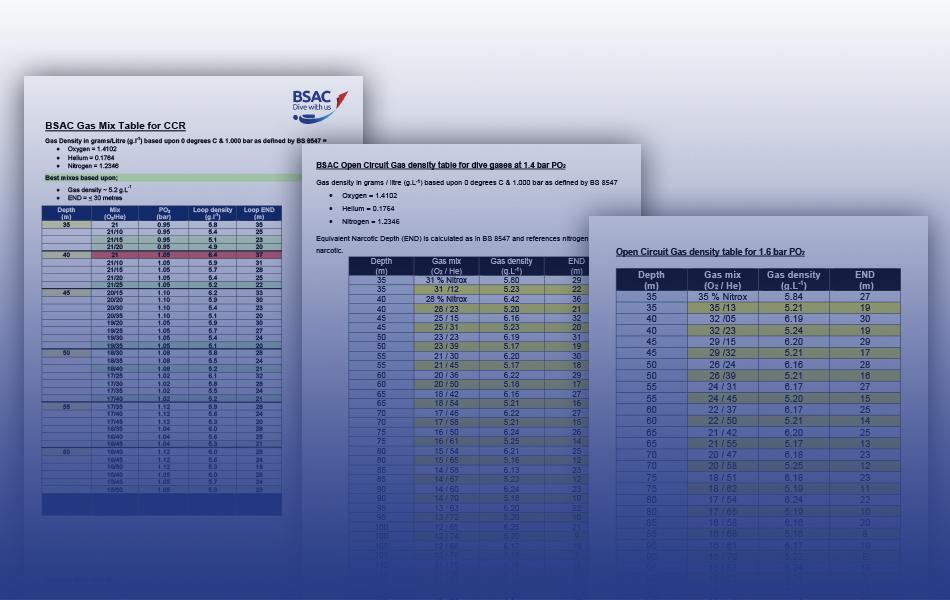
Following the recent publication of its new gas density tables, BSAC has now updated its recommended gas mixtures for Open-circuit Mixed Gas divers.
The new tables were aligned with findings from research conducted by Gavin Anthony and Professor Simon Mitchell that were presented in 2015 in a paper entitled Respiratory physiology of rebreather diving.
The original scientific paper was specifically aimed at rebreather diving but the research and conclusions are equally applicable to open-circuit diving. As such, since the publication of the new BSAC gas density tables, BSAC Technical Group has fully reviewed the recommendations for open-circuit mixed gas diving and has updated the recommended gas mixtures for open-circuit diving.
On the updated recommendations for open-circuit divers, BSAC Technical Instructor and formulator of the BSAC gas density tables, Mike Rowley said:
Gas density is now recognised as a key factor when considering gas mixtures for deeper dives, so it is important that this understanding is incorporated into BSAC training and procedures. The changes to the gas mixture recommendations for open-circuit diving are a significant part of this which should help divers choose to breathe an appropriate gas for their dive.
So what is gas density and why is it important for divers?
Gas density is a measure of mass per unit volume, measured in grams per litre (g/l). The deeper you go the density of the air you breathe increases. A high gas density means a given volume of gas weighs more and takes more effort to move, resulting in increased work of breathing (WOB).
Gas density is why WOB increases as we go deeper, and increased WOB, in turn, predisposes divers to CO2 retention. It is increasingly accepted that elevated breathing gas densities are dangerous and may well be implicated in exacerbating a range of diving ailments including not only CO2 retention but also O2 toxicity, nitrogen narcosis, decompression illness and immersion pulmonary oedema. Furthermore, elevated gas densities can impair the performance of breathing equipment such as regulators and rebreathers.
BSAC’s gas density tables are intended to support planning for safer deeper diving (> 40 metres) and are based on increased knowledge and understanding over recent years of the importance of gas density when breathing gases under pressure.
What are the tables exactly?
The BSAC gas density tables show in tabular form:
- Breathing gas densities for a variety of gas mixtures including air, nitrox, trimix and heliox at depths of 5m increments from 35 metres to 130 metres
- Equivalent narcotic depths (END) for each gas mixture and depth increment
There are three tables in total, two of which are for open-circuit gas mixtures. One is based upon a partial pressure of oxygen (PO2) of 1.4 bar. This table is for use by open-circuit divers choosing safe dive gas. The other open-circuit table is based on a PO2 of 1.6 bar and is intended for use by open-circuit divers choosing accelerated decompression gases and rebreather divers choosing open-circuit bailout gases.
Each table shows a range of breathing gas mixtures for each depth increment that come within the safe gas density parameters for that depth. Each table also has a much smaller table of “ideal” gas mixtures for the depth increments.
Download the gas density tables
What’s changed?
Traditionally BSAC has established recommended gases for diving based upon the partial pressure of oxygen (PO2) and equivalent narcotic depth (END).
However, gas planning should no longer be governed by the END but instead by:
- maximum partial pressure of oxygen (PO2);
- gas density
The new BSAC gas density tables show gas densities and END values for depth increments of 5 metres from 35 metres down to 130 metres.
Further information and support
You can view the gas density tables and recommendations online.
Please contact the Diver Resources Team with any questions, comments or feedback. They are available at drt@bsac.com or on 0151 350 6203.
Want to know more about technical diving?
For more advice and support on technical diving, from finding out if tech diving is for you, to CCR and open-circuit courses and safety information, visit the technical diving support section




